Term archive
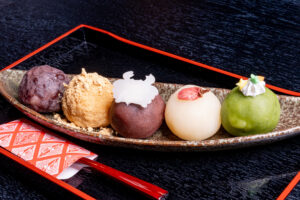
投稿タイプ:restaurants
Kamuin
This charming old Japanese house, located on a historic trail called Yamashiro-kodo Road, offers a delightful selection including traditional sweets. Ohagi is a traditional Japanese sweet made with glutinous rice and sweet bean paste, typically palm-sized. This cafe offers not only regular ohagi, but also a set of five bite-sized ohagi with different colors and designs. You can enjoy five flavors, including matcha green tea and kinako (roasted soybean flour). These pretty sweets have a refined sweetness and are very delicious. They are among the most popular sweets at this cafe.
In addition, there are a variety of special seasonal options available, such as shaved ices in summer, warm zenzai (dessert soup made with red beans) in winter, and a unique hamburger featuring a local specialty, bamboo shoots in spring.
Located near Kanimanji Temple, which has a connection with crabs, one of this cafe’s charms is the crab motifs that can be found throughout.

投稿タイプ:sightseeing
Kotokoto Beer
This microbrewery pioneered the craft beer scene in the Kyoto Tea Country region. Mr. Bando founded it in 2022, after working in the sake industry. He views craft beer as a fun way to bring people together, revitalize the community, and share the gifts of nature and agriculture with others.
Kotokoto Beer sells beers directly from the brewery. Additionally, it sometimes opens its weekend pub, which is mainly frequented by the locals, including many families with children.
In addition to their standard lineup that includes the weizen, the stout, the pilsner, and the IPA (India pale ale), they collaborated with local stores and farmers to develop a wide variety of beers. These unique beers include a tomato pilsner, a grape IPA, a coffee beer, and a beer made with strawberries that nearby farmers are struggling to sell.
Visit the brewery. Discovering a place through its craft beer is a wonderful experience.
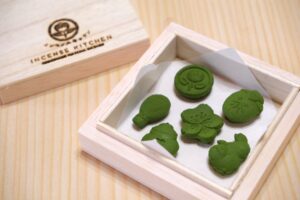
投稿タイプ:sightseeing
Incense Kitchen
Incense Kitchen offers a great experience of making incense with the aroma of matcha green tea. (Reservations are required. For English support, please apply at least one week in advance.) Why not try this wonderful experience unique to Uji, a famous tea region?
Matcha is an indispensable part of Japanese culture. Also, you can feel Japan's unique heritage from the wooden molds used here, which are traditional sweet molds. (Currently, specially crafted ones for the incense by a skilled artisan are used.) You can create incense with motifs of a rabbit, tea, a cherry blossom, and many more, which symbolize Uji and Kyoto. They are lovely to look at and will make your heart flutter.
The matcha is fresh, sourced directly from tea factories and tea farmers in Uji. The manufacturing process inevitably produces some high-quality matcha that is not sold for consumption, and currently, only this type of matcha is used here. You can contribute to reducing food waste in the community through this fun experience.
The incense is not lit directly; instead, it is gently warmed using a tealight candle. It releases no smoke, only the relaxing aroma of the matcha. It's perfect for personal enjoyment, and a gift for someone special, too.
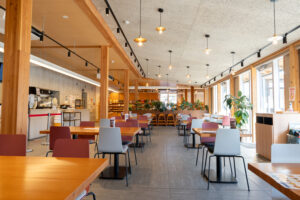
投稿タイプ:sightseeing
TEOTERASU IDE
Teoterasu Ide is a community hub for regional development and interactions that opened right next to Ide Town Hall in 2023.
Teoterasu Ide has a direct sales corner offering a wide range of goods such as fresh produce, bento boxed meals, sweets, alcoholic beverages, and more.
Additionally, it has a stylish cafe space serving its signature dishes made with local specialties. Ide Janmen is a spicy miso ramen made with local miso (fermented bean paste) and bamboo shoots. It’s very addictive. Ide Ohgon Purin (Ide Golden Pudding) is made with Kyoto’s eggs and Kyoto-produced milk. It’s a rich and creamy custard that highlights the natural flavor of eggs. You can find more food made with locally sourced ingredients.
The facility also serves as a gathering spot for local people. There are various events throughout the year, and it’s a fun place for all ages, from children to the elderly.
Visit Ide Town. Abundant nature, delicious food and warm people are waiting for you.
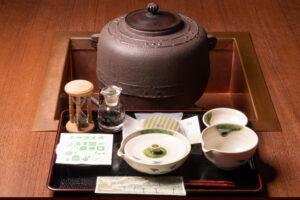
投稿タイプ:sightseeing
Kyotanabe Gyokuro Salon
Kyotanabe City Tourist Information Center was renovated in 2022. At the same time, Kyotanabe Gyokuro Salon, where visitors can feel free to experience the charm of Japanese tea, was newly established.
Here, you can learn how to brew gyokuro (luxury Japanese green tea), a specialty of the city, and how to make matcha (finely ground green tea that is whisked with hot water). The staff will guide you through the process in a cozy space with an irori (open fireplace). No reservations required.
They also provide tourist information about the city, and sell carefully selected local specialties, called “Kyotanabe Brand Ikkyuhin”.
Kyotanabe Gyokuro Salon is also attractive because of its convenient location near two stations. This is the perfect place to start sightseeing in Kyotanabe.
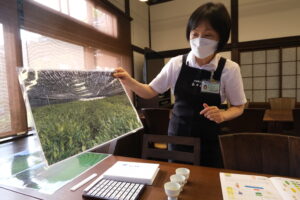
投稿タイプ:sightseeing
Uji Tea Ceremony Hall “House of Takumi”
You can enjoy a variety of tea experiences near Uji River. (Explanations in English are available.) For example, you can learn how to brew delicious Uji tea with the guidance of a Nihoncha (Japanese Tea) Instructor. If you are interested in matcha green tea, it would be wonderful to learn how to whisk up delicious matcha in a simple way. After that, you can draw or write what you want on the surface of your matcha, using dark green matcha. Finally, you can actually savor the flavor of your matcha. Chakabuki, a tea tasting and guessing game, is another fun experience. This game is available by reservation.

投稿タイプ:column
Hidden Gems of Kyoto: Exclusive Tourist Spots Revealed by Locals

投稿タイプ:column
JR Station Hopping: Local Gourmet Spots in Kyoto, Near Nara and Iga

投稿タイプ:column
Unique vegan and organic restaurants beyond Kyoto City

投稿タイプ:column
5 Amazing Experiences in Uji City Related to Uji Tea

投稿タイプ:column
9 Tranquil Onsen in Kyoto That Deliver Ultimate Relaxation

投稿タイプ:column
